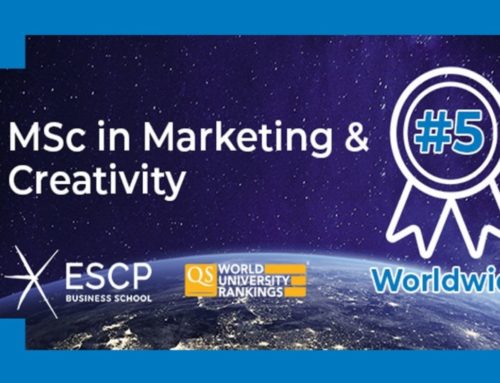Everything You Know About AI Is Wrong

The following is an excerpt from the book The AI Republic: Building the Nexus Between Humans and Intelligent Automation written by ESCP Business School’s Prof. Dr Terence C.M. Tse, Academic Director of the MSc in Digital Transformation Management and Leadership, Dr Mark Esposito, and Danny Goh.
 In 2015, the New York Times published a quiz designed to illustrate the writing capabilities of artificial intelligence technology. 1 Can you tell whether a human or a computer algorithm wrote the following passages?
In 2015, the New York Times published a quiz designed to illustrate the writing capabilities of artificial intelligence technology. 1 Can you tell whether a human or a computer algorithm wrote the following passages?
- “A shallow magnitude 4.7 earthquake was reported Monday morning five miles from Westwood, California, according to the U.S. Geological Survey. The temblor occurred at 6:25 a.m. Pacific time at a depth of 5.0 miles.”
- “Apple’s holiday earnings for 2014 were record shattering. The company earned an $18 billion profit on $74.6 billion in revenue. That profit was more than any company had ever earned in history.”
- “When I in dreams behold thy fairest shade
- Whose shade in dreams doth wake the sleeping morn
- The daytime shadow of my love betray’d
- Lends hideous night to dreaming’s faded form.”
- “Benner had a good game at the plate for Hamilton A’s-Forcini. Benner went 2-3, drove in one and scored one run. Benner singled in the third inning and doubled in the fifth inning.”
- “Kitty couldn’t fall asleep for a long time. Her nerves were strained as two tight strings, and even a glass of hot wine, that Vronsky made her drink, did not help her. Lying in bed she kept going over and over that monstrous scene at the meadow.”
- “Tuesday was a great day for W. Roberts, as the junior pitcher threw a perfect game to carry Virginia to a 2-0 victory over George Washington at Davenport Field.”
- “I was laid out sideways on a soft American van seat, several young men still plying me with vodkas that I dutifully drank, because for a Russian it is impolite to refuse.”
- “In truth, I’d love to build some verse for you
- To churn such verse a billion times a day
- So type a new concept for me to chew
- I keep all waiting long, I hope you stay.”
Here are the answers: 1. Computer, 2. Human, 3. Computer, 4. Computer, 5. Computer, 6. Computer, 7. Human, 8. Computer
This Is Not Business As Usual
How did you do? Don’t feel too badly if you failed miserably. Even the most experienced literary scholar would have trouble deciding which of the above examples was written by a flesh and blood human.
The quiz illustrates how much progress machines have made in doing the types of things humans can do. It’s clear that machines can already compose text in a way that is almost in distinguishable from human writing. This simply isn’t business as usual; there is something going on here that is more important than many technological breakthroughs of the past. We’ve never seen such ambiguity between humans and machines.
Or have a look at what modern computers can paint. ING and Microsoft, a global bank and a tech giant, respectively, have recently completed a project called The Next Rembrandt. 2 Drawing on the analysis of 346 of the artist’s paintings, a team of engineers used facial recognition technologies to create an original painting of the same name based on the styles and geometric patterns in Rembrandt’s portraits. 3
While this is exciting, and maybe a bit alarming, it’s important to remember that even if they can write decent poetry, machines cannot, and never will, completely replace humans. There are infact many roles machines will never be able to fill. To understand why, we need a better understanding of how AI fits into our world, and how it’s evolving.
Just How Intelligent Is Artificial Intelligence?
People often want to know if computers are becoming more intelligent than humans. This is an understandable, but ultimately unartfully phrased question. The underlying fear behind this question is the idea that AI represents an extraordinary technological development that has the potential to be smarter than we are, to maybe even dominate us. This is how the media, futurists, and science fiction frequently love to portray advance sin AI. We have been warned, for instance, that the only way for humans to survive is to merge with machines.4
Undoubtedly, we can no longer dismiss the need to work in close conjunction with machines. But how much of a “merger” is really required hinges on how you define intelligence. It is a basic fallacy to assume that human intelligence is something that AI can ever possibly hope to emulate. This isn’t the goal or end game for AI technology, either. In truth, what machines do isn’t anything close to intelligence: they merely excel in the computational space. In spite of terms such as “machine learning” and “neural network” (which will be discussed in greater detail later), they are only reproducing analytical functions of the human brain, but this is only one part of what our brains are capable of. While this logical and analytical space can be easily replicated, other parts of our brain cannot.
Computers are smart in the sense that they are the most efficient when it comes to complex calculations and raw data processing. Computers will always be better (“smarter”) than we are at that. Even a basic handheld calculator can process numbers at a speed we could never hope to achieve. With enough time (and math ability), you could do the same task, but a calculator will complete it in a nano second. In that sense, even a very dumb calculator is much quicker and smarter than we are. But is that intelligence? No, that is speed and raw number-crunching.
Arguably, there are some very advanced computational functions that computers can do now that we would never be able to accomplish as humans. But that is still not intelligence. Machines are grossly incapable of doing these things on their own; setting up the computers to perform a specific task still requires a significant amount of human input. A computer can perform statistical analysis, like calculating standard deviations and p-values, with commendable expediency and accuracy, but it cannot understand the purpose of doing so. The analysis and the resulting output are only meaningful thanks to the humans designing the study, picking the methodology, deciding what data needs to be collected, and calibrating carefully the calculating process. The human is still in the driver’s seat, making the big decisions that will guide them to the results.
It’s also important to remember that there are many things that machines cannot do very well. If you want a computer to help you dress better, for example, you will be out of luck. Achieving a superior sense of style is a far more difficult, subjective task to complete. Your welfare will be much better served by asking your closest fashionable friend for help or by hiring a human personal shopper, if you can afford it.
To us, the term artificial intelligence is misleading at it score, because it assumes a level of intellect that isn’t necessarily there. At this stage, AI has a long way to go before it becomes truly smarter than we are, and it may never get there. Yes, AI can do a lot of impressive things, but can it serve a bigger, broader purpose for our society?
The Challenges To The Rise Of AI
The rate of technological change is accelerating exponentially. How long did it take for the telephone to reach every house in America? It was invented in 1876, and it took more than fifty years for that technology to get into half of American households. It took radio thirty-eight years to reach 50 million listeners. How long did it take Facebook, which was invented in 2004, to reach 6 million users and then later 600 million users? About one and five years, respectively. 5 Launched on January 21, 2011, WeChat, a messaging, social media, and mobile payment app developed by China’s tech giant Tencent, reached 50 million users within a year. The number of users exceeded 1 billion some thirty quarters later. 6 There is no question that technology is now penetrating the market at a breakneck pace.
That said, some technologies never fully take off or become globally distributed. In Latin America, people still line up outside a bank to perform functions that are completed electronically elsewhere in the world. There are large parts of the world where electronic banking technology may never penetrate due to factors of cost and convenience.
Just like e-banking technologies, the pervasiveness of AI is much lower than what we have been led to believe. Despite the fact that today’s media is filled with news of AI and portrays its widespread adoption in societies and businesses, the reality is very different. The rapid and large-scale deployment of AI is mostly confined to the largest tech corporates. Most entities in other sectors have yet to even consider integrating AI into their operations.
There are several factors that are currently restraining the rise of AI – the biggest one being cost. It’s currently very expensive to design and employ AI systems. Most countries and companies around the world can’t afford this kind of tech and won’t be able to for many years. Right now, the largest players in AI are the United States, Japan, and China. Europe, which by no means is technological backwater, is lagging further and further behind and still has a great deal to catch up in this space. 7
From the perspective of companies, AI is not a shelf-ready product; you can’t simply buy a system and plug-and-play it in your business. For AI to work effectively, it needs to be tailored to the individual needs of an organization. It’s a substantive process of integration where software developers and architects meet managers to work together to address specific needs. And this is assuming that the business needs and project objectives have been properly identified. Very often, even that initial assessment or detection of needs demands a lot of work. On many occasions, companies realize the solution to their issue isn’t AI at all; what they need is to digitalize their processes and operations or to upgrade to a more modern infrastructure. Companies need to do plenty of homework before they can begin to dip their toes in the AI pool.
Another factor hindering the widespread use of AI is the hoarding of technology by major firms. Most AI tech that is developed by smaller firms is almost immediately acquired by larger companies like Amazon and Google. Often, leading corporates don’t acquire that tech with the intent of commercializing it and making it widely available. Instead, they use it to improve their own businesses. That technology is now off the market and unavailable for anyone else to use. They become a small, elite group of players in the AI world that have the power and war chests to heavily invest in the technology. They send scouts to smaller companies and quickly buy out useful technology, which then slows down the spread of technology and prohibits collaborative work to improve tech.
Way back in 2011, Marc Andreessen of Netscape fame wrote an article called “Why Software is Eating the World” explaining how prominent startups are “building real, high growth, high margin, highly defensible businesses.” 8 In the seven years that followed, these startups, now turned tech giants, have not only created such businesses but also increased their market dominance, often to the level associated with monopolies. 9 The result: they are choking smaller rivals with their superior competitive edge. 10 These days, with the same tech giants holding a lead in AI technologies, they will most likely monopolize AI technologies and continue to put constraints on growth and developments on any upcoming challengers.
The Enemy Within
The slow-going adoption of AI means it won’t be taking over the world, at least not any time soon. The media enjoys stoking worries about the “Rise of the Machines” because it gets it plenty of attention and page views. But you don’t need to lose sleep over this. After all, the real threats to society as we know it have been around forever. A huge disruptive scenario on a global level is far more likely to come about due to climate change, war, trade war, or political disruption.
Humans are a far greater threat to humanity than AI could ever hope to be. We should be far less worried about the threat of artificial intelligence and far more worried about the threat of human intelligence. In many ways, our fundamental human characteristics make us bad at making decisions and choosing a course of action. Our minds are tripped up by error and prejudice. 11 Adding advanced technology to a volatile social situation is just fuel to the fire. “It isn’t artificial intelligence I’m worried about; it’s human stupidity that concerns me,” said Peter Diamandis, founder of the X Prize Foundation as well as co-founder of Singularity University. 12 Historian Yuval Harari, on the other hand, warned that “one thing that history teaches us is that we should never underestimate human stupidity.” 13 In the end, it’s not the technology itself that’s going to make or break us. It’s the way we humans implement and use it. The way we tackle ethical and moral implications and apply the tech matters far more than the technologies themselves.
At Home, In The Republic
AI’s threat to humanity has been over played, but that doesn’t mean it’s not a major driving force in the technology and business world that is going to irrevocably change the way we live. Even though we may not know what our destination will end up being, we certainly know which directions we are going. And for sure, humans will be working hand-in-hand with machines in an ever-increasing number of activities. The “merger” of man and computers began long ago, the moment we accepted technologies into our lives.
We are using more and more digital devices in day-to-day activities. In fact, in many respects, people have not just welcomed the use of but delegated responsibilities to machines. Just ask yourself how many of us still memorize telephone numbers these days? How many people still resort to reading maps going from point A to point B? We would always prefer to be guided rather than having to figure out the ways ourselves. At the same time, we are becoming more inclined to handover privacy in exchange for convenience, as we are too happy to take advantage of “free” apps and online services by paying for them in the form of data.
This trend will only go on with improving machine intelligence as it will be able to assume – and automate – more and more important roles that humans have played in the past (think driverless cars). An implication is that our next social and technological developments will be much less dictated by governments, with their power to control diminishing. Instead, our choices will be shaped and informed by the available technologies (created by companies, in particular the tech giants) and how the others use them. 14 The number of “likes” or “stars” in rating you get don’t come from the state; they are given by other humans. Twitter is more powerful than tear gas. 15
The fact that the choice of how to charge ahead into the future and even the fate of nations lies in how human beings interact with AI – and how human intelligence is best combined with artificial ones – leads us to think that AI is effectively creating are public. The Oxford Dictionary defines “republic” as “a state in which supreme power is held by the people and their elected representatives, and which has an elected or nominated president rather than a monarch.”16
While we are less concerned with the second part of the definition, we strongly believe that with the rise of intelligent automation, the power of shaping the future is in the building of the nexus between humans and AI. Whether this will represent a force of good or bad really depends on how much we understand and how we use AI technologies. To us, now is the time to seek and deepen such understanding.
This book is written with this in mind. It tries to address AI’s huge transformative potential for businesses and society. It attempts to shed light on the reality of what AI technology can do and what it will be capable of in the future. It will offer explanations of the different terminology and jargon we use to talk about AI. We will also have a deeper discussion on the broader implications of AI’s increasing presence in our lives.
There is a lot of conversation right now on how to reconcile the capabilities of people and machines. While this is an important conversation, it’s not the purpose of this book. This book will skirt the moral and philosophical questions that surround AI and leave that for others to tackle. Instead, we would like to explain the context surrounding these conversations. We will discuss the historical legacy of AI technology, some of which has been around for many years. We will also discuss the triggers that cause this technology to accelerate in capability and use. We would like to help people recognize how and why they might employ AI in their own organization, or city, or country. Drawing on our experiences at Nexus Frontier Tech with helping our clients to integrate AI into their business capabilities, we will suggest a few ideas as to how companies can start to put AI into their organizations.
AI is not the answer to all our problems. There are many situations where employing AI could be detrimental to a business. The goal is not to simply replace old for new but to examine how AI can help advance the trajectory of your products or services. It’s a matter of figuring out the things that machines should do and could do better.
In the latter part of the book, we will look at what government scan and should do to take advantage of this technology, and the implications of doing so. Given that all three of us have children, we believe that it is a worthy exercise to examine how parents can help prepare the next generations to fit into the economy of the future.
AI is constantly evolving, and society is being forced to evolve along with it. The ultimate question to ask yourself as you read is this: what are the things you should be doing today to prepare for the world of tomorrow?
***
If you would to know more about our innovative, full-time MSc in Digital Transformation and Leadership and how it may help achieve your career objectives, we would like to invite you to attend a free online info session on Monday, 15th July at 18:00 BST (19:00CET).
This is a great opportunity to know more about:
- The programme curriculum and what are the key skills, competencies and knowledge that you will obtain on this master programme
- What is the relevance of the programme curriculum to the future job market and why you should consider joining this programme
- What projects you will be working on
- What do you need to know about the admissions process
- Fees & funding opportunities
Your questions will be answered live by the Programme Director Dr Terence Tse and the recruitment team!
To register, please click here
***
Footnotes
1 New York Times ‘Did A Human Or A Computer Write This?’, Sunday Review, Quiz, 7 Mar. 2015 https://www.nytimes.com/interactive/2015/03/08/opinion/sunday/algorithm-human-quiz.html (accessed on 1 October 2018)
2 https://www.nextrembrandt.com
3 We have decided not to include the actual picture of The Next Rembrandt here because we cannot tell to whom the copyrights and authorship are due. See Lanza, Emily ‘Who Painted Rembrandt? Copyright And Authorship Of Two Rembrandt Portraits’, The Legal Palette, 21 Feb. 2018 for implications <https://www.thelegalpalette.com/home/2018/2/21/who-painted-rembrandt-copyright-and-authorship-of-two-rembrandt-portraits>(accessed on 26 December 2018)
4 Kharpal, Arjun ‘A.I. Will Be ‘Billions Of Times’ Smarter Than Humans And Man Needs To Merge With It, Expert Says’ 13 Feb. 2018 <https://www.cnbc.com/2018/02/13/a-i-will-be-billions-of-times-smarter-than-humans-man-and-machine-need-to-merge.html>(accessed on 11 October 2018)
5 Dobbs, Richard, Manyika, James and Woetzel, Jonathan No Ordinary Disruption: The Four Global Forces Breaking All the Trends, (New York: Public Affairs), 2016
6 Statista. ‘Number of monthly active WeChat users from 3rd quarter 2011 to 3rd quarter 2018 (in millions)’,2018 <https://www.statista.com/statistics/255778/number-of-active-wechat-messenger-accounts>(accessed on 26 November 2018)
7 European Commission Communication From The Commission To The European Parliament, The European Council, The Council, The European Economic And Social Committee And The Committee of the Regions: Artificial Intelligence For Europe, 25Apr. 2018; Berggruen, Nicolas and Gardels, Nathan ‘A Wakeup Call For Europe’, The World Post, 27 September 2018 <https://www.washingtonpost.com/news/theworldpost/wp/2018/09/27/europe/?utm_term=.e984a5543bfa>(accessed on 26 November 2018)
8 Andreessen, Marc ‘Why Software Is Eating The World’, The Wall Street Journal, 20 Aug. 2011 <https://www.wsj.com/articles/SB10001424053111903480904576512250915629460>(accessed on 26 December 2018)
9 Ip, Greg ‘The Antitrust Case Against Facebook, Google and Amazon’, The Wall Street Journal, 16 Jan. 2018<https://www.wsj.com/articles/the-antitrust-case-against-facebook-google-amazon-and-apple-1516121561>; Brandom, Russell ‘The Monopoly-Busting Case Against Google, Amazon, Uber, And Facebook,’ The Verge, 5 September 2018, <https://www.theverge.com/2018/9/5/17805162/monopoly-antitrust-regulation-google-amazon-uber-facebook>(both accessed on 25 November 2018)
10 Aley, Doug ‘It’s Hard to Compete With Tech Giants Like Google and Amazon – But It Can Be Done’, Entrepreneur Europe, 18 Jul. 2018 <https://www.entrepreneur.com/article/316376>(accessed on 25 November 2018)
11 Kahnemann, Daniel Thinking Fast And Slow, (London: Penguin), 2011
12 Exponential Wisdom Podcast, Episode 33, 31March 2017, <http://podcast.diamandis.com/2017/03/31/episode-33-evolution-of-humanity-with-ai/>(accessed on 27 December 2018)
13 Huang, Eustance ‘”Never Underestimate Human Stupidity,” Says Historian Whose Fans Include Bill Gates And Barack Obama’, CNBC.com, 15 Jul. 2018 <https://www.cnbc.com/2018/07/13/never-underestimate-human-stupidity-says-historian-and-author.html>(accessed on 18 December 2018)
14 Susskind, Jamie Future Politics: Living Together in a World Transformed by Tech, (Oxford: Oxford University Press), 2018
15 Tufekci, Zeynep Twitter and Tear Gas: ThePower and Fragility of Networked Protest, (US: Yale University Press, 2018)
16 Oxford Dictionary. <https://en.oxforddictionaries.com/definition/republic>(accessed on 27 November 2018)
***
To keep reading, pick up your copy of The AI Republic: Building the Nexus Between Humans and Intelligent Automation by Terence C.M. Tse, Mark Esposito,and Danny Goh.





